North America's oldest Gurdwara offers a peek into the complex history of B.C.'s first Sikh settlers
From revolutionary poetry to encounters with the KKK, B.C.'s Gur Sikh Temple holds many stories

As you travel down South Fraser Way in Abbotsford, B.C., you will notice a deep orange flagoutside what looks like a typical frontier heritage house, with unassuming square windows and beige siding.
But inside, it is revealed to bea Gurdwara, with an elevated stage to accommodate the Guru Granth Sahib, the Sikh scripture, facing a large hallwith seating for hundreds of people.
This building is the Gur Sikh Temple, built by Sikh settlers who arrived in B.C. more than 100years ago. It is the oldest existing Gurdwara in North America.
The contrast between what is on the outside and inside ofthe buildingcaptures the tensionthose settlers experienced when they arrived in Canada, and sought to assimilate insociety whilemaintaining their Southeast Asian identity, says Sharanjit Kaur Sandhra, co-ordinator at the University of the Fraser Valley's South Asian Studies Institute and co-curator of exhibits at the Gurdwara's Sikh Heritage Museum.

"Outwardly it has a false front and the gabled roof, but inwardly it pays homage to every typical Gurdwara," she said.
She added that the settlers wanted to adaptCanadian features on the outside includingwearing western clothing without compromisingtheir identities, culture, religion, languagesand food.
'Whatever you can carry ... consider it yours'
Todaythe temple continues to serve as a place of worship, but it is also a National Historic Site andmuseum, as designated by former Prime Minister Jean Chretien on July 31, 2002.
It was built in 1911 by Sikh men who worked at the Abbotsford Lumber Company. Wantinga communal gathering place, the men asked their employer to provide them with wood for a Gurdwara.
"The lumber company said, 'OK, whatever you can carry on your backs, consider it yours,'" said Sandhra.

After completing 12-hourshifts at the mill, the men would haul the wood more than half a kilometre away to where the Gurdwara wouldbe built. All of the wood in the building was transported this way.
But thesupport from the lumber companydidn't last.
By 1930, one of the company's founding members also became a founding member of the Abbotsford Ku Klux Klan. According to a newspaper report,he firedbetween 40 and 50 employees as a gesture of "goodwill" toward white workers.

Built on the tallest hill
Despite the challenges, Sandhra says the Gurdwara is a prime example of embracing a new culture while keeping one's head high.
"When these Sikh men built this Gurdwara, they're also fighting the systems of racism," said Sandhra.
She says they chose to build the Gurdwara on the tallest hill they could find as a sign of prideand protestagainst the systemic discrimination experienced by people of colour.
On Nov. 16, 1918, as the Gurdwara started to attractpeople from across the border, a 70-foot-tall pole was installed to hoist theNishan Sahib,or Sikh flag,signifying the presence of the Sikh community in the neighbourhood. The flag is also visible from the Canada-U.S. border,about eight kilometresaway.

"Sikhs, who were coming from America, they followed the light bulb on top of that original Nishan Sahiband walked from America to this Gurdwara," said Sandhra.
Over time, the Gurdwaraalso became a hub for South Asians in North America who protested against colonial rulein India.
"They would come to this Gurdwara space and recite poetry. Poetry became their act of revolution," Sandhra said.
The poemswere aboutracism, labour exploitation, colonialismand colourism whichcontinue to berelevanttoday, she adds.
"So this Gurdwara wasn't just a place for Langar[communal eating], it wasn't just a place for a refuge. It was a place of revolution. It was an act of resistance to colonialism."
Past meetspresent
Today, Sandhra helps provide walking toursof the Gurdwara, which are available for free upon request.

During a school tour, Gurkirt Kaur Manhas, a Grade 12 student from Surrey's L.A.Matheson Secondary, said the Gurdwaragivesher a peek into her own past.
"It's like a personal connection where I'm not only learning as a student in Punjabi class, but it's a family connection where I get to learn more about my relatives, about my pioneers," said Manhas.
Fellow student Armaan Singh Thandhi saidhe feels an affinity to the Gurdwara and itshistorical significance.
"It represents the pressure they were dealing with not only to provide for their families and to build a community, but also to carry an image and to convince a country that was initially not receptive of them that we could be contributing members to the fabric of the Canadian society," he said.
Sandhra concurs.
"These walls, if they could speak, they would share and reverberate all those histories."
Corrections
- An earlier version of this story included a misidentified archival image of a gurdwara in New Westminster. The story has been updated with an archival photo of the Gur Sikh Temple in Abbotsford.May 30, 2022 5:40 PM PT












_(720p).jpg)


 OFFICIAL HD MUSIC VIDEO.jpg)
.jpg)



























































































